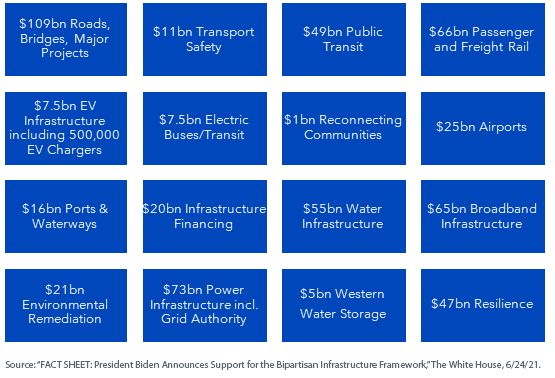Infrastructure Bill Beneficiaries Index Down 17% In June
Last November, President Biden signed the Infrastructure Investment and Jobs Act (IIJA) into law, allocating $1.2 trillion of spending with $578 billion of new spending over the next decade as outlined below:

Since the infrastructure bill’s enactment, the federal government has awarded, announced, or initiated funding for over $110 billion of spending across 4,300+ projects from which:
- Near-term, the immediate spending on the products and services that comprise infrastructure projects is expected to increase the revenues of the companies involved.
- Medium term, U.S. infrastructure companies involved are expected to:
- enjoy freed-up capital from government-funded improvements that should reduce initial and ongoing capital expenditure needs and improve margins,
- experience service improvements (rail operators, for example, should benefit from expanded and faster routes, while electric and water utilities should benefit from safer and more reliable service) that should expand their overall markets and revenues.
- Long-term, U.S. infrastructure companies involved should benefit from:
- the continued spending of the bill over the next 10 years
- and from the resulting infrastructure improvements.
Investors looking for exposure to infrastructure via public equities may want to consider investing in companies that generate a majority of their revenues from infrastructure-related business activities and the non-tradable munKNEE Infrastructure Bill Beneficiaries Index tracks 12 such companies that are described below, in alphabetical order:
- Brookfield Infrastructure Corporation (BIPC)
- With operations spanning utilities, transportation, energy, and even data infrastructure, BIPC should benefit enormously from business generated by the infrastructure bill.
- Caterpillar (CAT)
- As the manufacturer of asphalt pavers, compactors, excavators, pipe layers, backhoes, etc., CAT will benefit from future major infrastructure projects.
- ChargePoint Holdings (CHPT)
- With the expected building of 250,00 customized charging stations CHPT should benefit considerably from their involvement .
- Crown Castle International (CCI)
- As one of America's leading wireless tower real estate investment trusts, CCI should benefit from the expansion of mobile data usage.
- Deere & Company (DE)
- As a major producer of earthmoving and roadbuilding and forestry equipment DE should see an increased demand for its machinery.
- Eaton Corp. (ETN)
- As a major supplier of electrical components and systems ETN should benefit from the integration of wind and solar farms into the national grid.
- Freeport-McMoRan (FCX)
- Given that 43% of all copper mined is used in building construction, with another 20% used in transportation equipment, FCX should be a major benefactor.
- Martin Marietta Materials (MLM)
- As a producer of crushed sand and gravel products, ready-mixed concrete and asphalt, paving products and services, dolomitic lime for the steel and mining industries, and chemical products for use in flame retardants, wastewater treatment and assorted environmental applications MLM should be a major beneficiary.
- Nucor (NUE)
- As the largest domestic steelmaker in North America, the pent-up demand from automakers and other industrial buyers should benefit NUE considerably going forward.
- Oshkosh Corp. (OSK)
- As the manufacturer of specialty trucks used in heavy construction projects as well as cement mixers, truck mounted cranes, "cherry pickers" and other hydraulic lifting systems and being well placed to meet the demand for the electrification of the federal vehicle fleet OSK should prosper going forward.
- United Rentals (URI)
- As the provider of specialty equipment specifically designed for underground work and fluid treatment URI should benefit from business generated by the infrastructure bill. .
- Vulcan Materials (VMC)
- As America's largest producer of construction aggregates such as crushed stone, sand and gravel, and a major producer of asphalt and cement VMC will benefit from future major infrastructure projects.
NONE of the above constituent stocks advanced in June (-17.5%, on average), and NONE are above their stock prices at the beginning of 2022 (-24.5% YTD, on average). For individual constituent price changes click on the ticker hyperlinks.
One would expect the above companies to advance in the months - and years - ahead, so now it might be the ideal time to do your own due diligence and decide on which, if any, companies you think have the best prospects going forward.
Visit munKNEE.com and register to receive our free Market Intelligence Report newsletter (sample more



